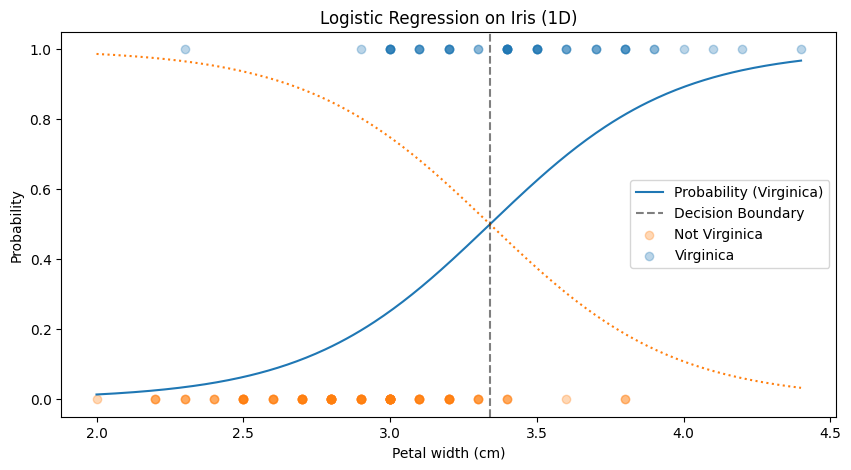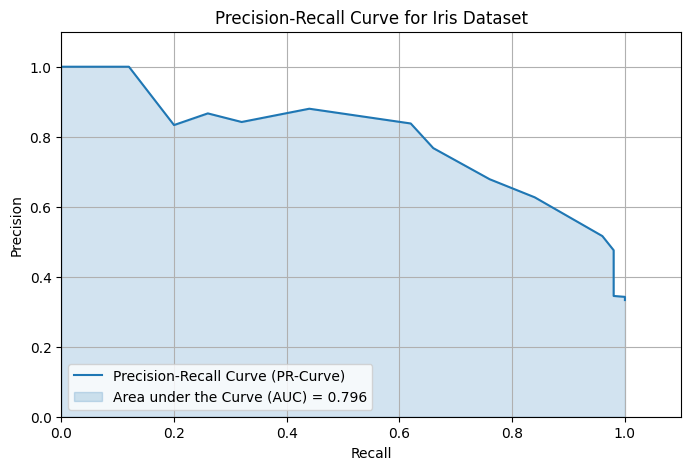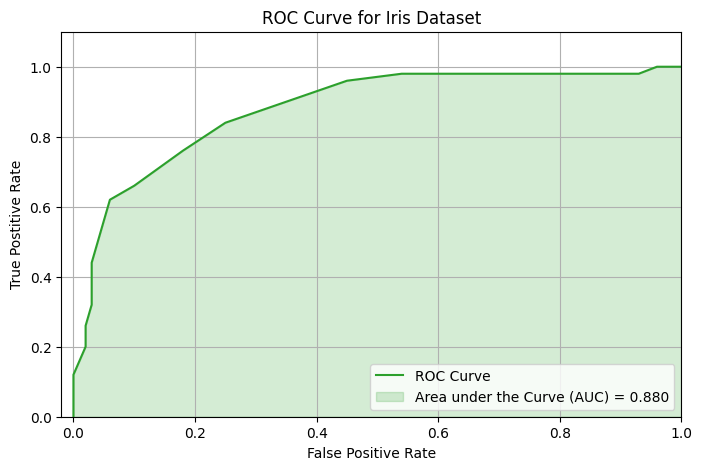When evaluating a classification model accuracy alone isn’t enough. To better understand how well your model is performing, we need to dig deeper by understanding metrics like precision, recall, F1 score, and performance curves like ROC and Precision-Recall (PR).
We’ll start by using the same classifier as in the Logistic Regression post.
from sklearn import datasets
from sklearn.linear_model import LogisticRegression
import numpy as np
import matplotlib.pyplot as plt
iris = datasets.load_iris()
X = iris["data"][:,1].reshape(-1,1)
y = (iris["target"] == 0).astype(int)
log_reg = LogisticRegression()
log_reg.fit(X,y)

The Confusion Matrix
Everything starts with the confusion matrix, which keeps track of four outcomes in binary classification:
- True Positives (TP): predicted positive, actually positive
- False Positives (FP): predicted positive, actually negative
- False Negatives (FN): predicted negative, actually positive
- True Negatives (TN): predicted negative, actually negative
From these four numbers, we can define our most important metrics.
from sklearn.metrics import confusion_matrix, ConfusionMatrixDisplay
y_pred = log_reg.predict(X)
cm = confusion_matrix(y, y_pred)
# Plot confusion matrix
disp = ConfusionMatrixDisplay(confusion_matrix=cm, display_labels=["Not Virginica", "Virginica"])
fig, ax = plt.subplots()
disp.plot(cmap='Blues', ax=ax)

Precision and Recall
Precision answers the question: Out of all the instances the model predicted as positive, how many were actually positive?
$$ \text{Precision} = \frac{TP}{TP + FP} $$
For example, in a spam filter, precision tells you how many emails flagged as spam were truly spam.
However, precision alone can be misleading. A model that predicts “spam” just once—and gets it right—but always says “not spam” after that, can still have perfect precision. But it’s clearly useless!
That’s where recall comes in. Also known as sensitivity or true positive rate, it answers: Out of all actual positive cases, how many did the model catch?
$$ \text{Recall} = \frac{TP}{TP + FN} $$
In the spam example, recall measures how many actual spam emails were successfully identified.
from sklearn.metrics import precision_score, recall_score
precision = precision_score(y, y_pred)
recall = recall_score(y, y_pred)
print(f"Precision: {precision:.3f}")
print(f"Recall: {recall:.3f}")
Precision: 0.838
Recall: 0.620
F1 Score
So both Precision and recall are important but it would be nice to combine them into a single metric. For this we use the F1 score; the harmonic mean of precision and recall:
$$ \text{F1} = 2 \cdot \frac{\text{Precision} \cdot \text{Recall}}{\text{Precision} + \text{Recall}} $$
Why harmonic mean? Because it punishes imbalance: if either precision or recall is low, the F1 score drops significantly. This makes F1 a great metric when you care about both catching positives and avoiding false alarms.
from sklearn.metrics import f1_score
f1 = f1_score(y, y_pred)
print(f"F1 Score: {f1:.3f}")
F1 Score: 0.713
The Precision–Recall Trade-Off
Most classifiers give a score or probability for each instance. To turn that into a decision, you pick a threshold (e.g., 0.5). Adjusting this threshold shifts the balance between precision and recall:
- Increase the threshold = higher precision but lower recall
- Decrease the threshold = higher recall but lower precision
This trade-off is context-dependent:
- In a spam filter, you’d want high precision — it’s okay to miss some spam, but misclassifying a real email as spam (false positive) is bad.
- In medical diagnosis, you want high recall — better to flag a potential issue and follow up than to miss a real case.
Precision-Recall Curve and PR-AUC
To visualize the trade-off, we plot the Precision-Recall (PR) curve:
- x-axis: Recall
- y-axis: Precision
You can trace this curve by varying the classification threshold from 0 to 1.
To summarize the entire curve with a single number, we use the PR AUC—the area under the precision-recall curve. A higher PR AUC indicates better performance across all thresholds, especially when positive cases are rare.
from sklearn.metrics import precision_recall_curve, auc
import matplotlib.pyplot as plt
# Predict probabilities for the positive class (Virginica)
y_scores = log_reg.predict_proba(X)[:, 1]
# Compute precision-recall curve
precision, recall, thresholds = precision_recall_curve(y, y_scores)
# Compute PR AUC
pr_auc = auc(recall, precision)
# Plot PR curve and fill area under it
plt.figure(figsize=(8, 5))
plt.plot(recall, precision, color="tab:blue", label="Precision-Recall Curve (PR-Curve)")
plt.fill_between(recall, precision, alpha=0.2, color="tab:blue", label=f"Area under the Curve (AUC) = {pr_auc:.3f}")

ROC Curve and ROC AUC
Another common performance curve is the ROC curve (Receiver Operating Characteristic). It plots:
- x-axis: False Positive Rate = FP / (FP + TN)
- y-axis: True Positive Rate = Recall = TP / (TP + FN)
A random model gives you a diagonal line (AUC = 0.5), while a perfect classifier reaches the top-left corner (AUC = 1.0).
$$ \text{ROC AUC} = \text{Area under the ROC curve} $$
ROC AUC is especially useful when positive and negative classes are balanced. It measures the model’s ability to rank positive instances higher than negatives, regardless of the threshold.
from sklearn.metrics import roc_curve, auc
import matplotlib.pyplot as plt
# Compute precision-recall curve
tpr, fpr, thresholds = roc_curve(y, y_scores)
# Compute PR AUC
pr_auc = auc(tpr, fpr)
# Plot PR curve and fill area under it
plt.figure(figsize=(8, 5))
plt.plot(tpr, fpr, color="tab:green", label="ROC Curve")
plt.fill_between(tpr, fpr, alpha=0.2, color="tab:green", label=f"Area under the Curve (AUC) = {pr_auc:.3f}")

PR AUC vs. ROC AUC
To summarize, use the Precision-Recall (PR) curve when your classes are imbalanced or you care more about the positive class, as it focuses on precision and recall. This might necessitate switching which class is the positive class (spam or ham?). The ROC curve works well when classes are balanced since it treats both classes equally. In short, PR curves highlight positive-class performance, while ROC curves measure overall discrimination.
